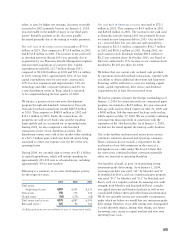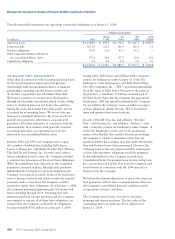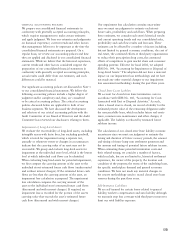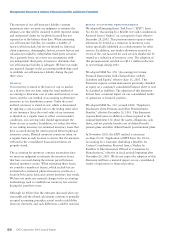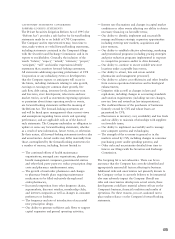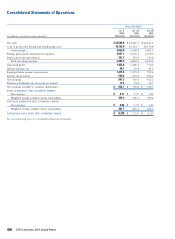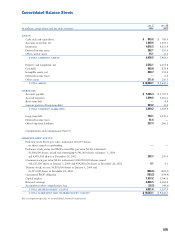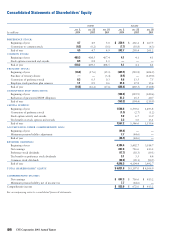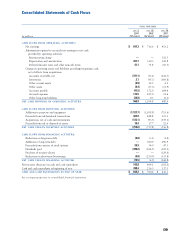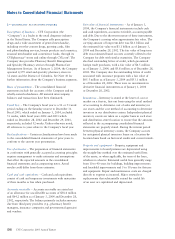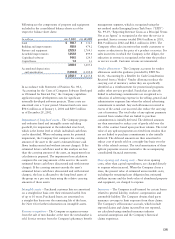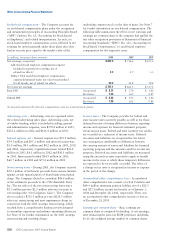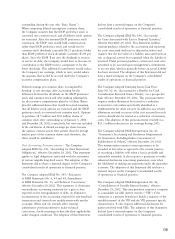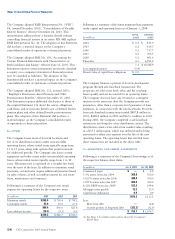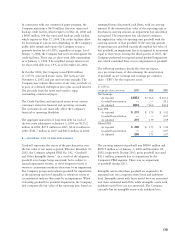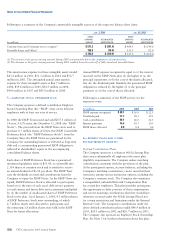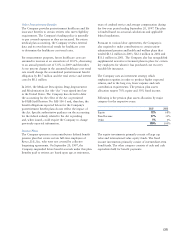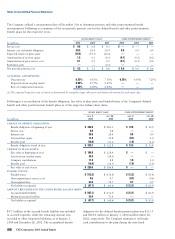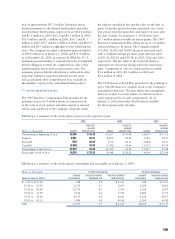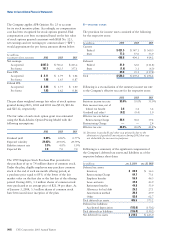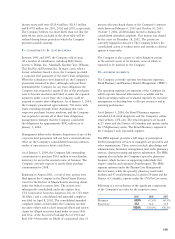CVS 2003 Annual Report Download - page 33
Download and view the complete annual report
Please find page 33 of the 2003 CVS annual report below. You can navigate through the pages in the report by either clicking on the pages listed below, or by using the keyword search tool below to find specific information within the annual report.
Following are the components of property and equipment
included in the consolidated balance sheets as of the
respective balance sheet dates:
In millions JAN. 3, 2004 DEC. 28, 2002
Land $ 180.7 $ 132.3
Building and improvements 492.8 479.2
Fixtures and equipment 2,123.3 1,769.3
Leasehold improvements 1,012.8 899.0
Capitalized software 149.5 124.5
Capital leases 1.3 1.3
3,960.4 3,405.6
Accumulated depreciation
and amortization (1,418.3) (1,189.8)
$ 2,542.1 $ 2,215.8
In accordance with Statement of Position No. 98-1,
“Accounting for the Costs of Computer Software Developed
or Obtained for Internal Use,” the Company capitalizes
application stage development costs for significant
internally developed software projects. These costs are
amortized over a 5-year period. Unamortized costs were
$90.6 million as of January 3, 2004 and $89.5 million
as of December 28, 2002.
Impairment of long-lived assets ~ The Company groups
and evaluates fixed and intangible assets excluding
goodwill, for impairment at the individual store level,
which is the lowest level at which individual cash flows
can be identified. When evaluating assets for potential
impairment, the Company first compares the carrying
amount of the asset to the asset’s estimated future cash
flows (undiscounted and without interest charges). If the
estimated future cash flows used in this analysis are less
than the carrying amount of the asset, an impairment loss
calculation is prepared. The impairment loss calculation
compares the carrying amount of the asset to the asset’s
estimated future cash flows (discounted and with interest
charges). If the carrying amount exceeds the asset’s
estimated future cash flows (discounted and with interest
charges), the loss is allocated to the long-lived assets of
the group on a pro rata basis using the relative carrying
amounts of those assets.
Intangible assets ~ Purchased customer lists are amortized
on a straight-line basis over their estimated useful lives
of up to 10 years. Purchased leases are amortized on
a straight-line basis over the remaining life of the lease.
See Note 4 for further information on intangible assets.
Revenue recognition ~ The Company recognizes revenue
from the sale of merchandise at the time the merchandise is
sold. Service revenue from the Company’s pharmacy benefit
management segment, which is recognized using the
net method under Emerging Issues Task Force (“EITF”)
No. 99-19, “Reporting Revenue Gross as a Principal Versus
Net as an Agent,” is recognized at the time the service is
provided. Service revenue totaled $96.0 million in 2003,
$84.9 million in 2002 and $82.1 million in 2001. The
Company offers sales incentives that entitle customers to
receive a reduction in the price of a product or service. For
sales incentives in which the Company is the obligor, the
reduction in revenue is recognized at the time the product
or service is sold. Customer returns are immaterial.
Vendor allowances ~ The Company accounts for vendor
allowances under the guidance provided by EITF No.
02-16, “Accounting by a Reseller for Cash Consideration
Received from a Vendor.” Vendor allowances reduce the
carrying cost of inventory unless they are specifically
identified as a reimbursement for promotional programs
and/or other services provided. Funds that are directly
linked to advertising commitments are recognized as a
reduction of advertising expense in the selling, general and
administrative expenses line when the related advertising
commitment is satisfied. Any such allowances received in
excess of the actual cost incurred also reduce the carrying
cost of inventory. The total value of any upfront payments
received from vendors that are linked to purchase
commitments is initially deferred. The deferred amounts
are then amortized to reduce cost of goods sold over the
life of the contract based upon purchase volume. The total
value of any upfront payments received from vendors that
are not linked to purchase commitments is also initially
deferred. The deferred amounts are then amortized to
reduce cost of goods sold on a straight-line basis over the
life of the related contract. The total amortization of these
upfront payments was not material to the accompanying
consolidated financial statements.
Store opening and closing costs ~ New store opening
costs, other than capital expenditures, are charged directly
to expense when incurred. When the Company closes a
store, the present value of estimated unrecoverable costs,
including the remaining lease obligation less estimated
sublease income and the book value of abandoned property
and equipment, are charged to expense.
Insurance ~ The Company is self-insured for certain losses
related to general liability, workers’ compensation and
automobile liability. The Company obtains third party
insurance coverage to limit exposure from these claims.
The Company’s self-insurance accruals, which include
reported claims and claims incurred but not reported,
are calculated using standard insurance industry
actuarial assumptions and the Company’s historical
claims experience.
(31)


